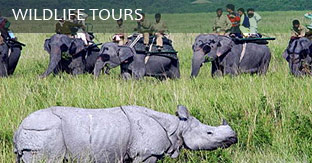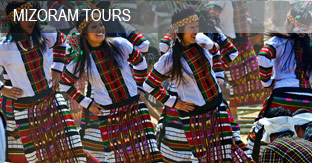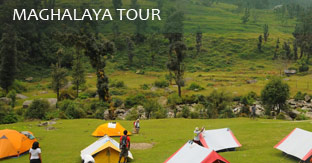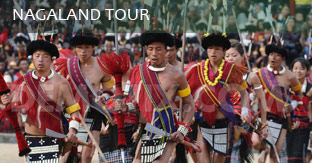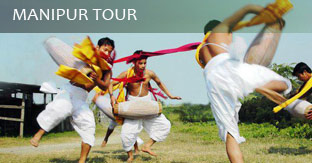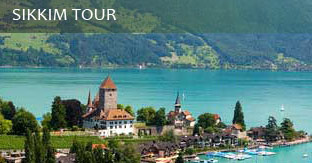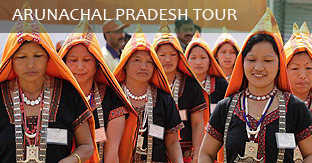TRIPURA, THE TINY STATE:
Tripura, the second smallest state in the country, is almost surrounded by Bangladesh. Inspite of having 19 tribes, the majority of the population of Tripura is Bengali. Situated in one of the remotest corner of the country, Trpura is one of the best potential places that caters the taste of everything from palaces to lakes and hill station.
Neermahal, a summer resort at south Tripura, built by late Maharaja Birbikram Kishore Manikya way back in 1930, attract a good number of tourists every year. The Ujjayanta Palace, a dominating built in Agartala, was built by Krishna Kishore Manikya Bahadur in 1901.
The ancient land of Tripura located in the North Eastern region of India between 22.56 deg and 24.32 deg North Latitude and 90.09 deg and 92.20 deg East Longitude and is bounded on the north, west, south and south-east by the international boundary of Bangladesh. In the east it has a common boundary with Assam & Mizoram. 60% of the total area is under hills and forests. This tiny state has an area of about 10,500 sq. kms and is inhabited by largely 19 tribes Bengali, Manipuri and other communities.
HISTORY
The ancient history of Tipperah or Tripura is shrouded with mystery. We come to learn from Rajamal that more than 150 tribal kings ruled Tripura since the legendary period and King Ratnapha got the title “Manikya” from the Lord of Gauda. But recent readings of Tripura Coins have proved that Ratna had his two predecessors Maha Manikya and Dharma Manikya. Hence it is perhaps reasonable to conclude that with Mahamanikya, the historical period of the “Manikya” Dynasty started, which continued till 1949. The history of the rulers of Tripura in medieval period is the story of continual fights, particularly with the Sultans of Bengal.
During the British period, some English officials were eager to occupy Tripura, but it was opposed by others. However, the office of the British Political Agent of Tripura was created in 1871. After the death of Birbikram Kishore Manikya in May 1947, a Council of Regency under the leadership of his widowed wife Maharani Kanchanprava Devi took over the charge of the administration on behalf of the minor prince.
The Regent’s rule came to an end on September 9, 1947, when due to popular pressure, the agreement of Merger of Tripura with the Indian Union was signed by the Maharani on 15th October 1949. Finally, Tripura became a full-fledged State in January 1972.
The original inhabitants of the land, i.e. the hill people were noted for their tolerance and passive obedience. It is only in the 19th century that they started protesting against the oppressive Feudal System.
FLORA & FAUNA
Sepahijala Wild Life Sanctuary, is about 25 kms from Agartala covering an area of about 18 sq kms.It houses about 150 species of birds and the unique spectacled monkey. There is also a botanical garden, zoo, lake and boating facilities nearby. The Trishna Wild Life Sanctuary is located about 100 kms away.
FAITH & CULTURE
There are only four predominant communities in Tripura professing different religious beliefs – Hindus, Muslims, Buddhists and Christians. Most of the tribal people have their own tribal customs and beliefs but in a broader sense of the religion they are believed to be followers of is Hinduism. They worship elements such as the god of water, the god of fire, the god of forests, the god of earth etc. A trace of their old faith is found in their present practice of striking a bamboo in the ground during religious festivals and worshipping it. Sacrifices form an important part of their religion; the buffaloes, pigs, goats and fowls being the animals ordinarily used for this purpose.
Most of the modern members of the ruling family of Tripura were great patrons of art and literature and had great regard for eminent scholars of the country. Maharaja Dharmamanikya is said to have inaugurated the rajmala, a verse chronicle of the royal house. Tripura, a neighbouring state, have had a spiritual contact with Bengal for well over a few centuries and this contact became all the more significant during the period due to Tagore’s continued association with the ruler and his benign influence over them.
Teachers were brought from Mithila for the spread of Music in the State. A flute made of Muli Bamboo of Tripura was very famous. There are also their own improvised musical instruments like Sarinda, Chougpreng and Samu (flute) etc. made of bamboo and strings.
The songs are mostlly related to their days work and different songs are sung on different occassions. Dancing in Tripura has always been in complementary lines with Music and it has always been a very popular aspect of cultural functions. The Garia dance is very popular among the Tripuris.
HANDICRAFTS
Loin-loom, indeed is the oldest and most developed cottage industry of Tripura. Among the traditional produces mention may be made of dubris (a piece of skirt to be wrapped twice over the body) riha or risa (breast garment); bed-covers, screens, asanas etc. Silk is another age old industry of Tripura. Next to weaving, cane and bamboo works occupy place of prominence. Bamboo is available in super abundance, and this typical forest wealth of Tripura is one material that is used in many ways from building homes to making toys. Many artistic things are made of bamboo or its roots for example toy, tray, vase, photo-frame, human figure, casket, calender, pen-stand etc.
FAIRS AND FESTIVALS
Of the many festivals which are celebrated in Tripura, the worship of fourteen Gods popularly known as “Kharchi Puja” occupies a place of pride. This is celebrated with great enthusiasm in the month of July every year. The first day of this week long festival is declared a holiday by the Government. Ker and Garia Puja- these two traditional tribal festivals, need special mention. Ker Puja starts generally fifteen days after Kharchi Puja. It is said that this puja is performed for the welfare of the state and its people. The puja is performed within a specific boundary & during the puja nobody is allowed to enter or come out of this specified boundary. The Garia Puja is performed on the sevventh day of the month of Baisakh (April). When the Puja is over, the devotees, men and women take to dancing.
Another remarkable tribal festival is Ganga Puja. This puja is held in March-April. About 4 to 5 Villages join together to perform this puja. To perform the puja they build a temple of bamboo just on the middle of the river. They sacrifice goats, buffaloes and ganders and pray to God to save them from epidemic disease. Durga Puja in the month of October is one of the most popular festivals of Tripura. Next comes Diwali, on the occasion of which each year a big fair is held near Matabari in the temple of Tripura Sundari at Udaipur. “Ashokastami fair” is held at Unakoti Tirtha at Kalishahar every year in the spring. Thousands of pilgrims assemblle here to offer prayers to the images of Goddesses engraved on the hilly rocks which are found here.
PLACES OF TOURIST INTEREST :
Agartala
The State Capital is connected by road with Guwahati via Shillong by National Highway No. 44. It takes about 24 hours by road from Guwahati to reach Agartala. There are flight connections as well, with Calcutta and Guwahati.
Ujjayanta Palace
This is a modern building of the royal house of Tripura and is located in the heart of Agartala, sprawling over a half sq. kms. This two storeyed mansion has a mixed architechture with three high domes ( the centre one being 86′ high). The magnificient titles floor, curved wooden ceiling and beautifully crafted doors are particularly notable. The palace was built by Radha Kishore Manikya in 1901. Its well laid out gardens have two large tanks on either side and the fountains are laid out in the patterns of the Mughal Gardens. Kunjaban Palace situated 1 Km ahead on a hillock, was constructed in 1917 and named as Pushbanta Palace by the than ruler, Maharaja Birendra Kishore Manikya. It is said that the known poet Rabindra Nath Tagore stayed in the eastern apartment of the palace. The southern side is now open to the public and is known as Rabindra Kanan, while the rest of the palace is now the official residence of the Governor of the State.
Neermahal
A Summer resort built in 1930 by the late Maharaj Birbikram Kishore Manikya Bahadur, is about 55 kms away from Agartala. It is built in the middle of a Lake called Rudrasagar with a total area of about 5.35 kms. A perfect blend of Hindu and Mughal architecture it is the only Lake Palace in Eastern India. Half of the Palace is an open-air theatre and the other half on the Western Side is called the Andar Mahal, used by the Royalty.
EXCURSIONS
Unakoti
The Rock-Cuts and stone carvings of Tripura are huge and have been carved on open vertical walls at Unakoti, Debtamura and Pilak. Unakoti is about 178 kms from Agartala. The name Unakoti means one less than a crore and legend. It is a Shivva pilgrimage site dating back to the 8th or 9th century. The central Shiva Carving known as the Unakotiswara Kal Bhairava is about 30 feet high, its head dress is 10 feet in height. Evvery year a big festival known as Ashokastami Mela is held here in the month of April.
Debtamura
This is 75 kms from Agartala and is situated on the banks of the river Gomati between Udaipur and Amarpur. The rocks on the banks of the river are also called Chabimura and are images of Shiva, Vishnu, Kartik, Mahisasur, Mardini Durga and other deities. The images date back to the 15th and 16th Century.
Pilak
The Stone carvings found here are mostly in stone and terracotta plaques. This is located about 100 kms away from Agartala.
Mata Tripureshwari Temple
Located at Udaipur about 58 kms away from Agartala and 3 kms from Udaipur, is considered one among the 51 pithasthans of India according to Hindu Mythology. It is also known as Kurma Pith because of the shape of the temple resembling the tortoise. The idol of Maa Kali is made of reddish black stone and is in the Soroshi form.
The Fourteen Goddess Temple
Is situated about 14 kms from Agartala at a place known as the old Agartala. The famous Kharchi Festival is celebrated here during the month of July each year.
Bhuveneshwari Temple
On the right banks of the Gomati River, was buillt by Maharaja Govinda Manikya, during 1660-75. It finds its reference in Rabindra Nath Tagore’s poetry and drama.
Jampui Hills
The luxuriant forests of ‘Jampui Hill’, the premier one among the 6 principal hill ranges of Tripura provides a life time’s exhilarating experience for the tourist.’Jampui Hill’ – the permanent seat of spring, is situated at an altitude of about 3000 above sea level and about 250 km away from Agartala. This hill range consists of cluster of tribal villages and is home for colourful Lushai and Reang tribal communities. The neat and clean traditional wooden houses of the local inhabitants combined with greenery all around provide excellent opportunities for eco-friendly tourism. During the month of November every year, the unique Orange Festival is celebrated in the Jampui Hill.
Note: Customized tour package to this state could be made to suit your travel time and requirement..

